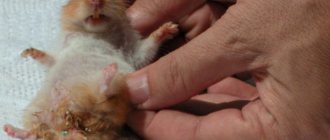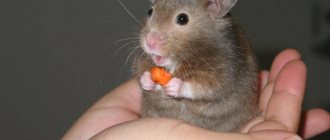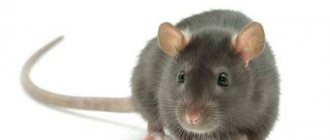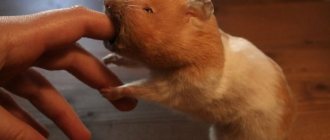Risk factors
Hamster breed
Any rodent can experience severe diarrhea, but some breeds are not susceptible to ileitis. For example, dwarf hamsters.
Among patients with “wet tail”, Syrian rodents with long hair are often found. When choosing a hamster breed, study its characteristics, including propensity and ileitis. It would be a good idea to consult with the breeder and veterinarian.
Extra attention
Desulfovibrio is a bacterium that often affects young hamsters under 8 weeks of age. Weak immunity is not able to resist the pathogen. It is worth paying attention to the health of a small animal before buying it from a nursery.
Handling is dangerous
Severe stress can trigger the appearance of a “wet tail.” This often affects young rodents that are taken from their mother before the age of two months. Strengthening the immune system of a young hamster occurs within a week in a new family.
Important! When buying a small animal, do not rush to handle it often. The hamster will need time to adapt.
Gastrointestinal diseases
Ileitis in hamsters occurs as a result of E. coli entering the body. Common reasons:
- poor quality food;
- non-compliance with terms and conditions of its storage;
- irregular replacement of water in the drinking bowl;
- wet and untreated litter.
Such conditions provide a favorable environment for the development of bacteria.
Wet tail is a consequence, not a cause
At best, severe diarrhea may be due to a less serious illness. However, ileitis is difficult to treat even under the supervision of a veterinarian.
The first symptoms should be a signal to contact a veterinary hospital. It will take a lot of time and effort to save a pet.
Prevention:
- two-week quarantine for each new individual purchased;
- buying a hamster not at a poultry market, but at a nursery, from a breeder with an impeccable reputation;
- balanced diet and stress prevention;
- hygiene: regular washing of the cage and accessories;
- disinfection.
If your previous hamster had wet tail disease, you need to thoroughly disinfect all equipment before getting a new pet. The cage is washed with soap and water and treated with a product containing bleach. You can scald it with boiling water. After treatment, the cage is ventilated for 2 months.
Symptoms of the disease and methods of diagnosing it
The main danger of the disease is that the latent period can last several weeks, so you can buy an already sick animal whose disease is in the incubation period. Hamsters aged 3-8 weeks are most vulnerable to the disease.
“Wet tail” is the name used among the people. In professional language, bacterial
the infection will be called proliferative ileitis, since, first of all, the ileum suffers from it. The animal begins to have diarrhea: first it is watery discharge, and then bloody discharge, which has a characteristic foul odor. The back of the hamster is wet, which is why the disease has earned its popular name. Often the animal experiences rectal prolapse, because the intestines constantly suffer from spasms. Diarrhea leads to dehydration, and in this condition the rodent can live no longer than three days. The disease can be diagnosed only by clinical symptoms.
The incubation period can last 10 days. There are clinical signs of “wet tail” in hamsters:
- severe diarrhea with a strong odor;
- blood appears in diarrhea;
- the animal sits hunched over;
- the fur is tousled, the shine of the coat has disappeared;
- restless and aggressive behavior.
Due to abundant liquid secretions, the back of the body becomes wet. The animal is severely dehydrated. Loss of appetite leads to sudden weight loss.
Symptoms of proliferative ileitis:
- Prolonged lack of appetite;
- Weakness, apathy, drowsiness;
- Change of behavior to aggressive and cruel;
- Wet back of body due to constant diarrhea.
Isolate your sick hamster
Ileitis is a contagious infectious disease. To prevent other pets from catching the disease from a sick hamster, it is better to house the rodents during treatment.
Important! The infection spreads not only due to direct contact between hamsters. A healthy animal can become infected from a sick animal through the owner’s hands, toys and other objects.
The right decision would be to temporarily transfer custody of healthy rodents to a family friend. This measure will help prevent the spread of the disease.
Restore your pet's water balance
Severe diarrhea causes the hamster to lose moisture from its body. The animal refuses to consume food and liquid.
Check the degree of dehydration as follows. The owner needs to carefully feel the withers behind the ears of the small animal with his fingers. If the fold straightens out immediately, then the fluid content in the body is considered acceptable. In a sick hamster, the skin fold very slowly returns to its previous shape.
Injections are the fastest and most effective method of combating dehydration. The owner can independently inject under the skin, but intra-abdominal administration of drugs is performed only by the hand of a veterinarian. The following drugs are used:
- ringer's lactate;
- 9% saline;
- 5% glucose solution.
The dose is prescribed by the veterinarian according to the weight of the sick hamster.
Treat your pet at home
When the first symptoms of a “wet tail” appear, the responsible owner is faced with the task of reducing diarrhea. Cereal decoctions are suitable for this.
Important! Cereal decoction and other folk methods only temporarily relieve the rodent from severe pain and diarrhea. Self-medication at home does not lead to recovery. The entire incubation period must be supervised by a veterinarian.
Keep your hamster warm
Small mammals are characterized by a high ratio of the body surface to its mass. Therefore, sick hamsters are prone to severe hypothermia. This condition poses a danger to a weak body.
The optimal temperature for a hamster in a room is 21-26 0C. The owner should prevent the appearance of drafts in the place where the cage with the sick animal is located. The litter must be clean and dry.
Reduce stress
While the animal is under the care of a veterinarian, its owner can contribute to a speedy recovery. To do this, you need to eliminate possible stressful situations in this way:
- do not move the rodent unnecessarily (only to the veterinary hospital);
- even an isolated animal should have a secluded place to rest;
- the hamster must sleep at any time of the day, for this reason family members try not to make noise near the cage;
- A recovering pet will want to climb and dig again; you should not deprive him of this opportunity.
To restore strength, the hamster will need time, silence and a calm environment.
Hygiene
The disease will progress if:
- do not change the litter;
- do not monitor ventilation and humidity in the room with the cage;
- keep your diet the same.
Disinfection of the cage is a mandatory measure when identifying ileitis in a hamster, because the infection spreads through secretions.
If a sick hamster dies and a cage remains behind, then you need to replace all possible parts of it:
- drinking bowl;
- feeder;
- sunbeds;
- ladders and other equipment.
What remains is treated with a disinfectant solution. Any detergent that contains chlorine will do. Then the cage is rinsed generously with water and ventilated. Such measures will preserve the life and health of the new pet.
Be prepared to make a difficult decision
“Wet tail” in most cases cannot be treated. Animals that survive the disease acquire immunity, but complications with the digestive system are possible.
If treatment started on time does not improve the pet’s condition, then you need to be ready to let him go. It is important that the animal is given a chance.
Eliminate fruits and vegetables from your pet's diet.
Changing your diet can feel like new stress for your hamster. The incubation period requires avoiding vegetables, fruits and other watery foods that will contribute to diarrhea. Dry food will ease the animal's condition. A diet of grains (wheat, oats and wheat) will strengthen the stool. When using ready-made mixtures, you need to make sure that they do not contain any suspicious additives.
Shedding
A complete or partial change of coat is called molting. It has two varieties:
- Age - young animals develop denser hair instead of a soft fur coat. The process usually occurs unnoticed by the owner, at the age of about four months.
- Seasonal – associated with the seasons. Spring and autumn molting are most typical for animals. If they hibernate in winter, they shed their fur in summer.
Regarding hamsters, it is impossible to say for sure whether they shed. Of course, the fur is renewed, and if the rodent is healthy, its owner does not even notice it. But in many ways this process depends on hereditary factors and conditions of detention.
If the hamster is healthy, then fur renewal is a completely natural process.
If your pet is losing hair, keep an eye on him. Is he active, eating well and not itchy? Most likely it's molting. If you wish, you can do a visual test - blow on the fur and carefully examine the hair. For example, in Djungarian hamsters it has three colors, and when the fur is renewed, their number increases to six.
Methods of treating the disease
IMPORTANT! We advise you to consult a veterinarian rather than follow advice from the Internet. Always remember that such articles may not be written by DOCTORS.
Eliminating the pathogen
Wet tail is an intracellular bacterium, so you need to resort to an antibiotic that can penetrate the cell and destroy the pathogen. Medicine for hamsters must be selected carefully so that the drug does not have a toxic effect (many antibiotics that are suitable for treating rodents cannot be used on hamsters).
Human medications can be used for treatment - oral suspensions. You can take Biseptol, which combines two active ingredients.
Also, most often, therapy is carried out using Baytril 2.5% (administer 0.4 ml over the skin of the animal per 1 kg of live weight). For a small rodent weighing 250 g, 0.1 ml is enough. Usually the antibiotic is injected once a day for a couple of weeks, and in difficult cases - twice a day.
Dehydration
The cause of death is dehydration, which occurs quite quickly with profuse diarrhea. Trying to give the hamster water is useless, since the liquid will not stay in the cells after passing through the digestive tract. The bad news is that rodents are too small, so intravenous injections are contraindicated for them. The best option for hamsters is intraperitoneal and subcutaneous injections. The owner can inject himself under the skin, but only a professional should inject into the stomach.
For injections, Ringer's Lactate is used, but you can use regular saline as an alternative: for 1 kg of live weight you need to take 40 ml of liquid. At the same time, you will need to inject glucose: 5% of the drug is injected into the body 2-3 times a day. To strengthen the immune system, vitamin C and Catozal are used together with the above drugs.
Treatment should be carried out in a well-washed cage, and hygiene procedures should be constant. When the rodent has completely lost its appetite, you can feed it manually: it is fed with baby formula (without milk protein) from a pipette or insulin syringe. Any succulent food should be excluded from the diet, but care must be taken to ensure that there is no significant loss of water.
Conditions of detention before recovery
The cage needs to be washed every day and the bedding changed to provide a warm and dry environment for the pet and to prevent re-infection of the animal. Juicy food must be completely excluded from the diet.
Proliferative ileitis is a difficult disease that cannot often be cured, even if proper and timely therapy is provided. If treatment attempts are completely excluded, then in 90-100% of cases the rodent dies. Owners can be quite principled when it comes to treating their pets. They exclude antibiotics because of the great harm they cause to the liver, and they consider injections to be a great stress that can kill the hamster. But the real danger comes from the disease, and antibiotics and injections are the only chance for salvation.
How to prevent baldness
To avoid possible hair loss, provide your pet with comfortable living conditions. Protect him from stress, offer toys for an active lifestyle. Keep the cage clean - wash it regularly and change the bedding. A correct and balanced diet is very important: only high-quality products should be on the menu, periodically give the animal vitamins, but do not overdo it. If you surround your hamster with love and care, he will feel great and delight you with his health and good mood.
Traditional methods of treatment
Traditional methods can be quite effective in treating human diseases, but with animals the situation is different. Not all recipes that help people are suitable for animals, so you need to be very careful. If you are sick, it is better to consult a veterinarian, but if this is not possible, then you can try using a decoction of grain crops (barley and oats are most often used). This remedy will help stop the diarrhea, and then there should be enough time to take the patient to a veterinary clinic. Traditional methods are aimed at eliminating symptoms and gaining time, and not at fighting the cause.
Cystitis
Inflammation of the bladder or cystitis often occurs from hypothermia. Rodents do not have good thermoregulation, so even an ordinary draft can provoke it. The most important rule is to protect your pet from hypothermia:
- hide it from the fan and open windows;
- remember its sensitivity to temperature changes;
- protect from drafts.
Simple rules, but how many difficulties can be avoided by simply closing the window in time! With cystitis, a hamster experiences a burning sensation when urinating and constant pain in the lower abdomen. He won’t be able to talk about it, but it’s possible to find out about the disease. As with colibacillosis, cystitis makes the hamster's fur wet. Losing fluid in such quantities can lead to dehydration.
It is because of the similarity of symptoms that you need to seek a final diagnosis from a specialist. If you suspect inflammation of the bladder, you should immediately go to a veterinary hospital, where they will tell you exactly what happened to your pet. Typically, for cystitis, your veterinarian will prescribe antibiotic treatment. To prevent this, it is better to take care of your pet’s health in advance.
What to do if you suspect a “wet tail”?
If you observe the above symptoms in your hamster, you need to immediately show him to a veterinarian; self-medication is extremely dangerous in any case.
Since we are dealing with an infectious and extremely contagious disease, you need to isolate the sick hamster, especially if you have more than one. Place your pets separately, for example, in 3-liter jars. Throw away everything that was in the cages (food, bedding). The cage should be treated with some kind of disinfectant (including the drum, feeder and drinking bowl).











